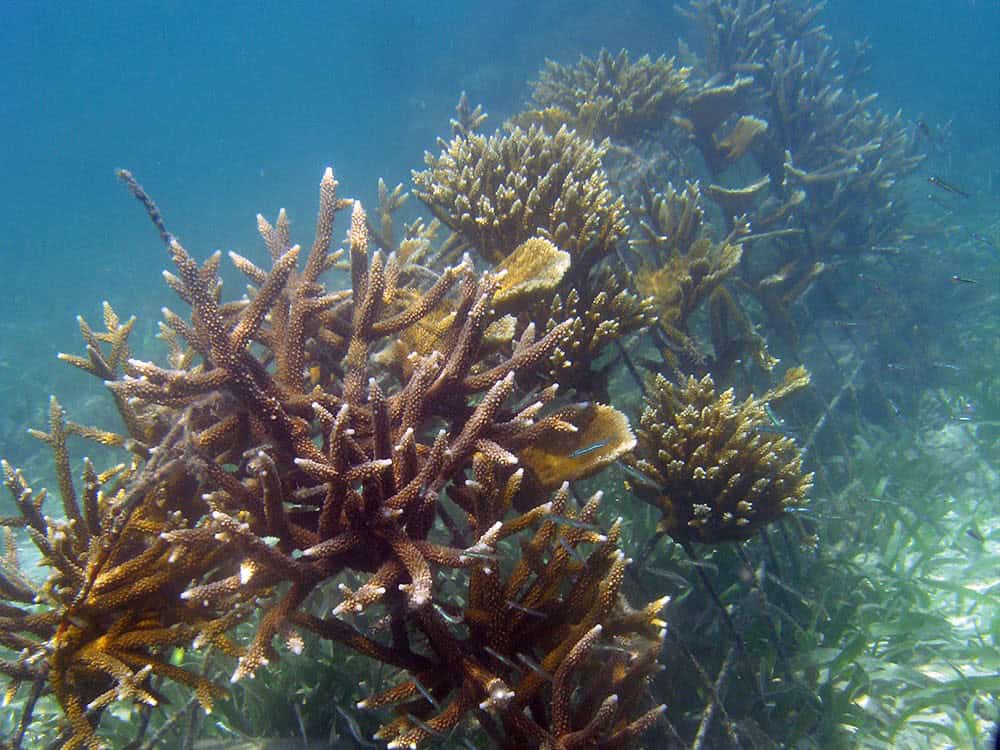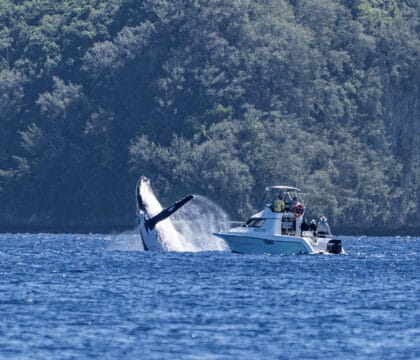November 18, 2025 • Blue Habits Tips, Program Updates
November is Coral Bleaching Awareness Month, a time to highlight the urgent threats facing coral reefs, as well as the actions we can take to support their recovery. Coral reefs are some of Earth’s most important ecosystems. They cover less than one percent of the ocean floor but support a quarter of all marine life. As temperatures rise and human impacts intensify, these vital ecosystems face unprecedented stress.
In honor of Coral Bleaching Awareness Month, this post explores the causes and consequences of coral bleaching, highlights global restoration successes, and explores the ways that individuals and communities can support reef resilience.
What Is Coral Bleaching?
Coral bleaching occurs when corals expel the symbiotic algae known as zooxanthellae that live in their tissues. These algae, which help give corals their vibrant colors, provide them with energy through photosynthesis. Under stress, corals release the algae, revealing their white skeletons underneath and giving the appearance that they have been “bleached.” Bleached corals are not dead initially, but they become vulnerable to starvation and disease if the stress persists. Prolonged bleaching can lead to widespread coral mortality.

Coral Bleaching in American Samoa, Before (Dec 2014) & After (Feb 2015) © The Ocean Agency
What Causes Coral Bleaching?
The primary cause of coral bleaching is elevated ocean temperatures, often triggered by climate change. Warmer waters stress the coral-algae relationship, prompting the expulsion of zooxanthellae. Other factors that contribute to bleaching include increased solar radiation, pollution from runoff, and changes in salinity or nutrients. Mass bleaching events, like the fourth global event confirmed in 2024, impact reefs across the world when temperatures exceed thresholds for weeks.
Alarming Coral Bleaching Facts:
- Nearly 75% of the world’s coral reefs are threatened by climate change and local human activities.
- During severe bleaching events, up to 50% of coral can die in affected areas.
- Coral reefs contribute $375 billion annually to the global economy through fisheries, tourism, and coastal protection.
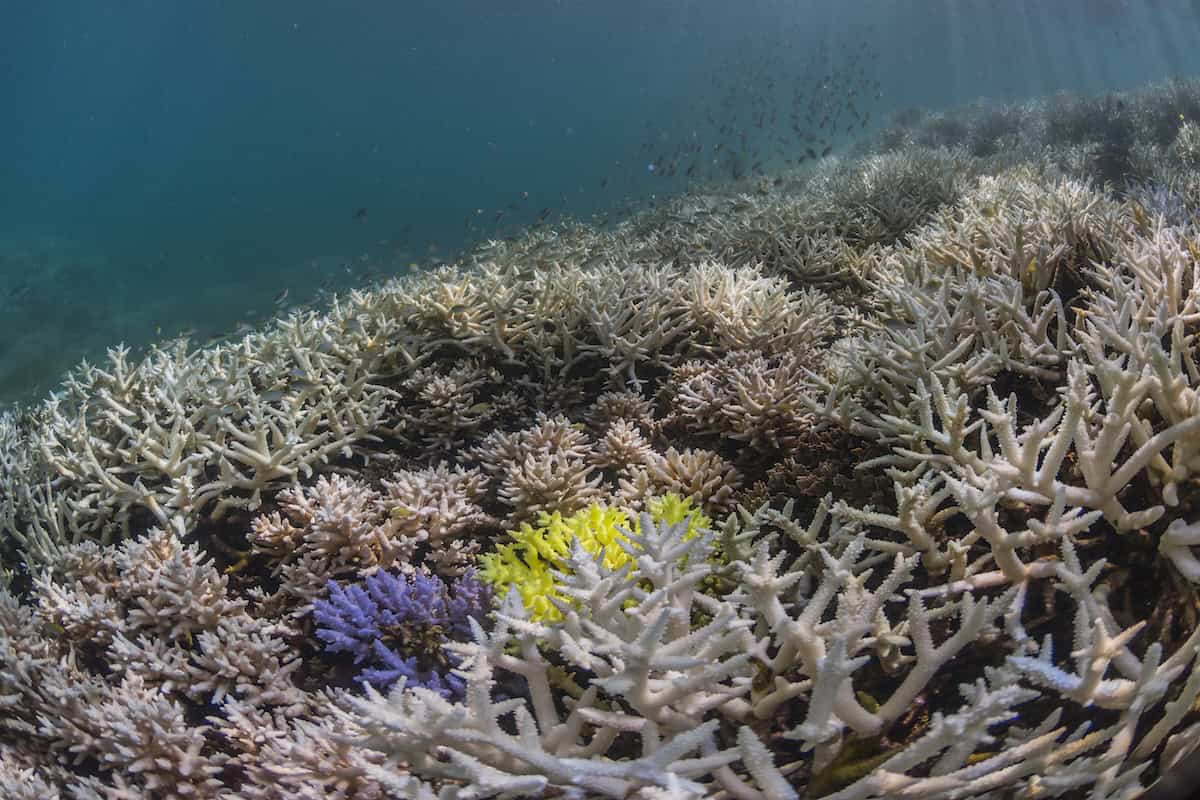
Purple and yellow fluorescing coral (New Caledonia, 2016) The Ocean Agency / Ocean Image Bank
Bleaching Impacts on the Ocean & People
Coral bleaching impacts reverberate through the ocean. Healthy reefs act as nurseries for countless fish species, and they support commercial fisheries that feed millions of people worldwide. When corals bleach and decline, fish populations shrink, threatening not only ocean health but also both food security and local economies.
Reefs also act as natural barriers, protecting coastlines from erosion, storms, and flooding. Their degradation leaves coastal communities more vulnerable to damage and economic loss. Biodiversity suffers as thousands of marine species lose critical habitat, triggering cascading effects throughout the food chain.
Ocean acidification, driven by excess carbon dioxide in the atmosphere, worsens the problem by weakening coral skeletons and making recovery even more difficult.

Fishermen in Fiji rely fishing for their livelihoods, but coral bleaching and reef decline are shrinking fish populations—threatening food security and the health of the ocean they depend on. ©Tom Vierus / Ocean Image Bank
Why Conservation Organizations (Like Oceanic Society) Are Especially Concerned
- Frequency & Scale of Bleaching Events: We are currently in the midst of what scientists call the 2023–2025 global coral bleaching event, the fourth such event on record, affecting an estimated ~84% of coral reef ecosystems globally. This scale of heat stress is unprecedented and demonstrates how pervasive and serious the threat is. Such events have been happening in more places and with greater frequency due to our warming climate.
- Ecosystem Integrity: Bleached corals are more vulnerable to disease, reduced growth, and death. If coral populations decline, the entire reef structure and its biodiversity suffer. Reef animals rely on healthy coral for habitat, food, and nursery space
- Human & Economic Impact: Coral reefs are not just ecological treasures; they also support human livelihoods through tourism and fisheries, and protect our coastlines from storms. When bleaching damages them, it threatens food security, livelihoods, and even shoreline stability.
- Recovery Limits & Resilience: Even when corals do recover from bleaching, their ability to reproduce and resist future stress can be impaired. Because bleaching is happening more frequently, there is less time for full recovery between events.
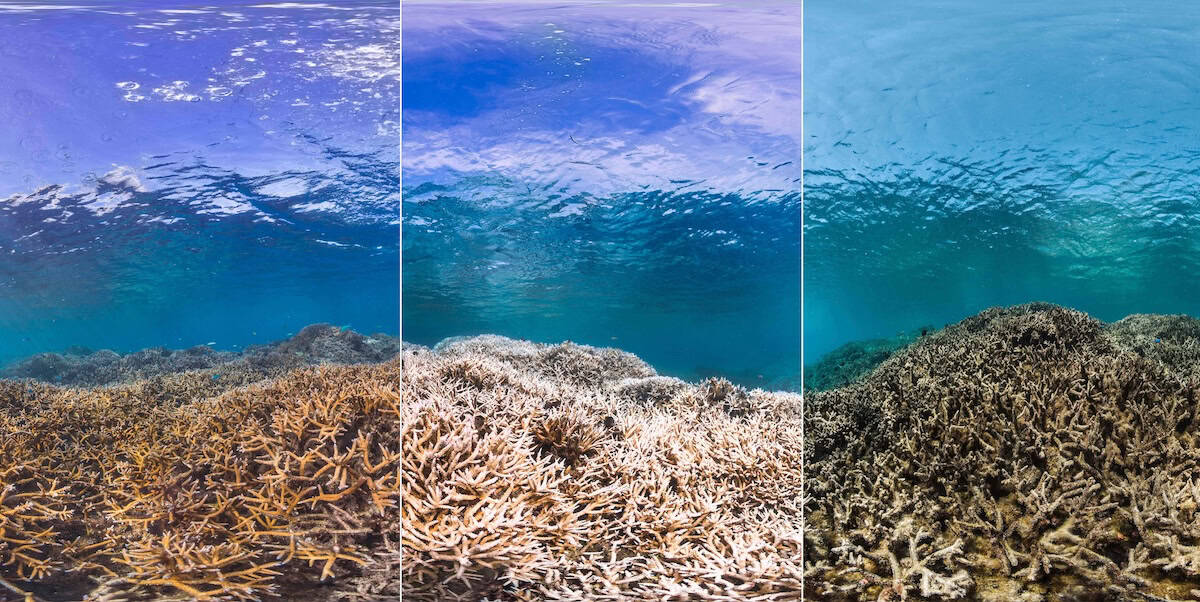
Coral Bleaching, American Samoa: Before (healthy Dec 2014), during bleaching (Feb 2015), and after (dead August 2015) © Ocean Image Bank
Global Improvements and Wins in Combating Coral Bleaching
Amid ongoing bleaching challenges, organizations around the world are working to restore coral reefs and improve their resiliency in the face of a warming planet. Some notable recent efforts include:
- Mars Coral Reef Restoration Program (Indonesia & Maldives, 2024)
- Out planted over 80,000 corals across 24 projects
- Achieved 56–80% survival rates across 20 species
- Some corals grew up to 17 cm per year, helping repair damaged reefs
- Emphasizes community and NGO training to build local capacity
- Great Barrier Reef Innovations (Australia, 2024)
- Introduced protective holders to shield juvenile corals from predators
- Trialed “cryo-born” baby corals, frozen and grown in labs, for greater genetic diversity
- More than half of the lab-raised corals survived the early stages
- Led by the Australian Institute of Marine Science to develop heat-tolerant coral lines
- Fragments of Hope (Belize)
- Community-led nonprofit restoring reef habitat since 2006
- Operates 23+ coral nurseries, out-planting genetically diverse, resilient corals
- At Laughing Bird Caye National Park, live coral cover has increased from ~6% to ~60%
In the images above, the A-Frame method was used to out plant corals, illustrating growth over one year: left shows Day 0, right shows the same domes one year later. ©Fragments of Hope
- Coral Restoration Consortium (Worldwide)
- A global hub for coral restoration, connecting scientists, practitioners, and local communities to share best practices, tools, and innovations
- Their interactive coral restoration map shows active coral restoration projects worldwide, providing a real-time view of where efforts are happening and who is leading them
- SECORE International (Worldwide)
- Advances coral restoration through sexual reproduction techniques
- Coral Attachment Breakthrough (2025) study found securing coral seeding units with a drill & bolt method led to 2–4× more live recruits after 6–8 months
- Mission: Iconic Reefs (Florida, USA)
- NOAA-led initiative restoring seven priority reef sites in the Florida Keys by 2040
- In response to the 2023 bleaching event, NOAA and partners committed $16M for research and restoration
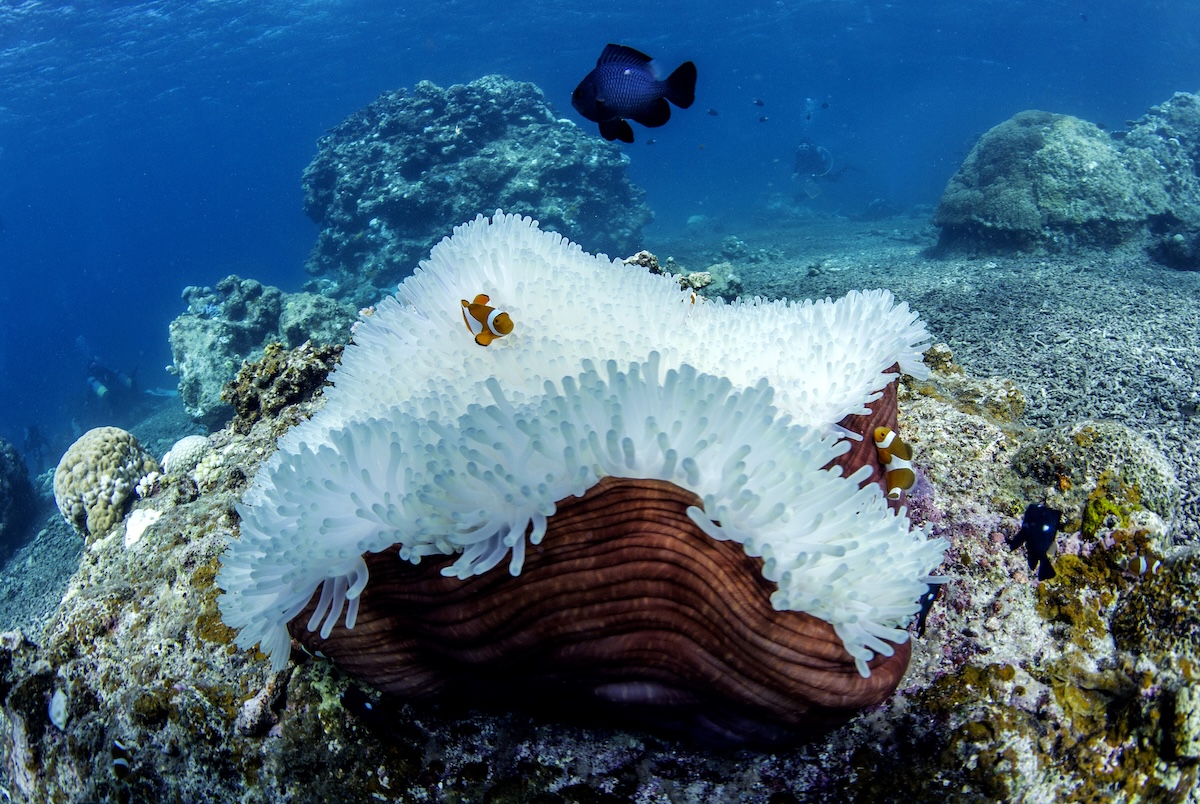
Clownfish weave through anemones on Okinawa’s reefs, which were already showing signs of stress before the widespread coral bleaching of 2016. © The Ocean Agency / Ocean Image Bank
Supporting Coral Reefs Through Responsible Travel
At Oceanic Society, our mission is to improve ocean health by deepening connections between people and nature to address the root cause of ocean decline: human behavior. Coral bleaching directly challenges this work, as reefs are foundational to marine biodiversity and the livelihoods of coastal communities.
Our expeditions are deeply influenced by coral health, and coral bleaching is central to how we think about responsible travel and purposeful itineraries.
- Trip Destinations: We prioritize reef areas that are both ecologically important and where conservation and restoration efforts are active. Supporting these areas helps protect reefs under stress.
- Guest Education: Part of our mission is to help travelers understand what they are seeing in the water. When bleaching is visible, we explain what it means, why it is happening, and what is being done to help. This deepens the travel experience, as it’s not just a trip, it’s an opportunity to learn and support.
- Restoration & Research Support: On some programs, we support or partner with coral restoration projects, either through direct volunteer work, providing financial support, or raising awareness. By bringing guests to these sites, we can help channel resources and knowledge to critical reef systems.
- Sustainable Practices: We emphasize low-impact snorkeling and diving, reef‑friendly sunscreens, and behaviors that minimize stress on corals. That helps limit further damage and shows that tourism can be part of the solution, not the problem.
How to Help Prevent Coral Bleaching Damage
Awareness is the first step toward action. Coral Bleaching Awareness Month encourages individuals to educate themselves and others about coral health and marine ecosystems, knowing that each step taken collectively can slow warming and restore balance. Simple choices today build resilient oceans for tomorrow.
Actions You Can Take to Make a Difference
- Reduce your carbon footprint by using public transportation, switching to renewable energy, and conserving electricity to lower global warming.
- Evaluate products in your daily life:
- Sunscreen: Opt for mineral-based sunscreen formulas with zinc oxide or titanium dioxide, avoiding oxybenzone and octinoxate, which cause bleaching. Look for “reef-safe” certifications from groups like Protect Land and Sea.
- Personal Care Products: Choose biodegradable shampoos, lotions, and soaps to prevent chemical runoff into oceans.
- Minimize pollution: Cut back on fertilizer and pesticide use in your yard to reduce runoff that stresses reefs.
- Select sustainably sourced seafood: Use seafood guides when shopping or opt for seafood certified by the Marine Stewardship Council to reduce overfishing pressure on bleached reefs.
- Advocate for change: Support policymakers who are committed to fighting climate change.
- Practice responsible reef visits: Avoid touching corals while snorkeling or diving, and choose operators committed to sustainable practices.
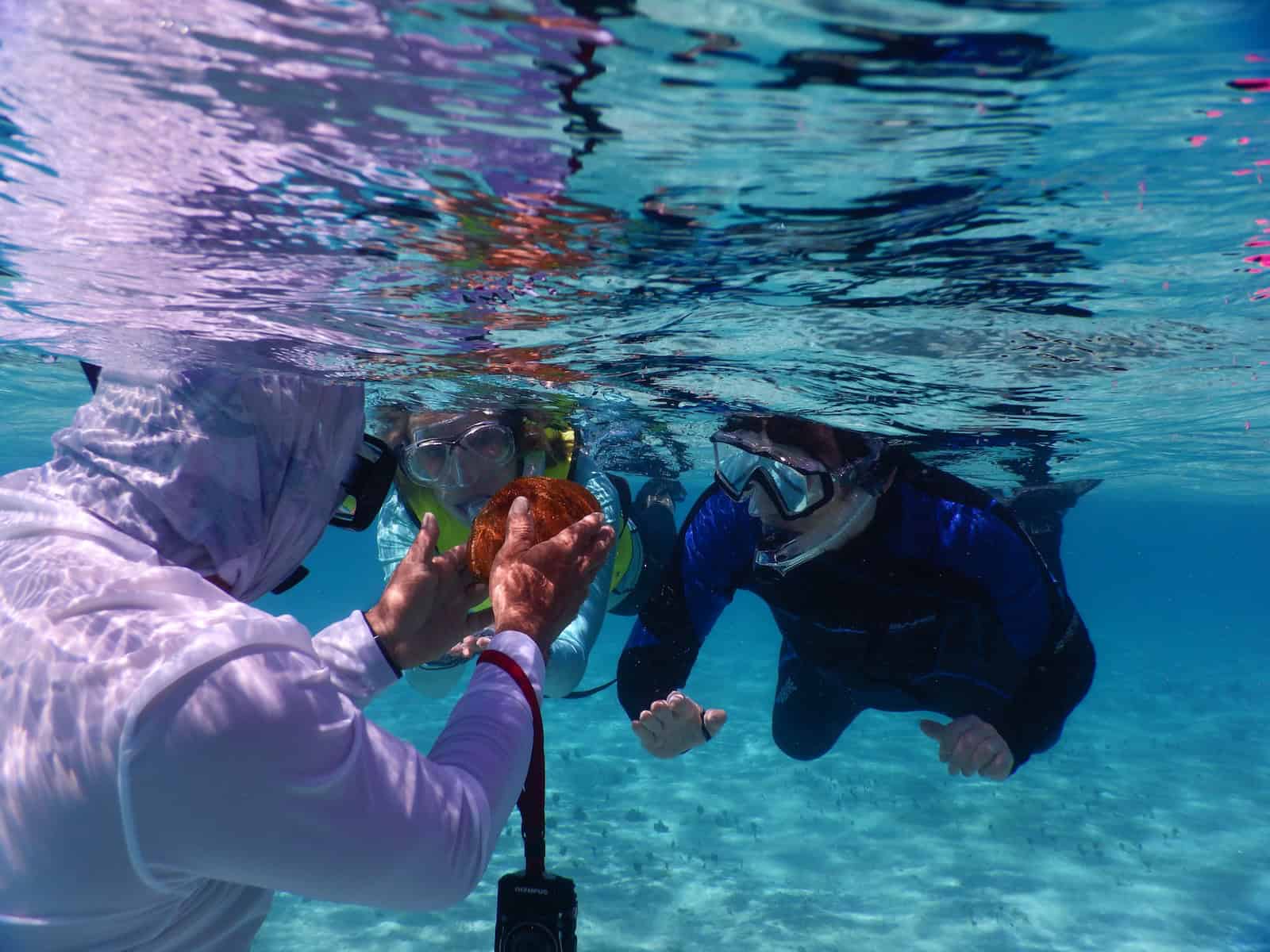
Participate in Hands-On Conservation
Volunteer on coral reef restoration trips with Oceanic Society and partners to protect reefs and contribute to scientific research.
Films to Watch for Deeper Understanding
Documentaries offer engaging ways to learn about coral bleaching and reef conservation. Here are three recommended films, blending timeless classics with recent releases:
- Ocean with David Attenborough (2024): A feature-length special focusing on ocean health, including bleaching threats and restoration efforts. It emphasizes global solutions and human impacts.
- Chasing Coral (2017): This Netflix film follows scientists documenting mass bleaching on the Great Barrier Reef. It uses stunning visuals to explain the crisis and calls for urgent change.

- Blue Planet II (2017): Produced by the BBC, this series explores ocean ecosystems, with episodes highlighting bleaching impacts on marine life. David Attenborough’s narration makes complex science accessible.
Groups to Follow for Ongoing Awareness
Consider following these leaders in coral conservation:
- NOAA Coral Reef Conservation Program: Provides scientific updates on bleaching events and tools for reef monitoring. Follow for data-driven insights and policy advocacy.
- Coral Reef Alliance (CORAL): Focuses on protecting reefs in key regions like the Coral Triangle. Their resources include bleaching alerts and community stories.
- Reef Check Foundation: Empowers volunteers worldwide to monitor reefs and track bleaching. Join their network for citizen science opportunities.
- Coral Restoration Foundation: Leads large-scale restoration projects in Florida and beyond. Follow for progress on transplanting resilient corals.
Building a Brighter Future for Reefs
Coral bleaching is a critical challenge, but every action counts. By learning, advocating, and making thoughtful choices, whether through sustainable products, supporting restoration efforts, or reducing your carbon footprint, you can help protect these vital ecosystems.
This November, join the coral conservation movement by taking one concrete step to support coral reefs and encouraging others to do the same. The health of our oceans depends on collective effort, and together, we can ensure vibrant reefs, thriving marine life, and resilient coastlines for generations to come.


